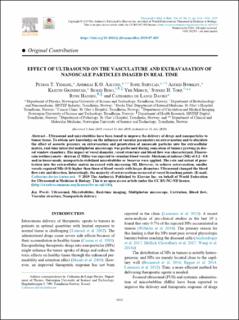| dc.contributor.author | Yemane, Petros Tesfamichael | |
| dc.contributor.author | Åslund, Andreas K. O. | |
| dc.contributor.author | Snipstad, Sofie | |
| dc.contributor.author | Bjørkøy, Astrid | |
| dc.contributor.author | Grendstad, Kristin | |
| dc.contributor.author | Berg, Sigrid | |
| dc.contributor.author | Mørch, Ýrr Asbjørg | |
| dc.contributor.author | Torp, Sverre Helge | |
| dc.contributor.author | Hansen, Rune | |
| dc.contributor.author | Davies, Catharina de Lange | |
| dc.date.accessioned | 2020-11-11T07:47:44Z | |
| dc.date.available | 2020-11-11T07:47:44Z | |
| dc.date.created | 2019-11-20T12:54:49Z | |
| dc.date.issued | 2019 | |
| dc.identifier.citation | Ultrasound in Medicine and Biology. 2019, 45 (11), 3028-3041. | en_US |
| dc.identifier.issn | 0301-5629 | |
| dc.identifier.uri | https://hdl.handle.net/11250/2687241 | |
| dc.description.abstract | Ultrasound and microbubbles have been found to improve the delivery of drugs and nanoparticles to tumor tissue. To obtain new knowledge on the influence of vascular parameters on extravasation and to elucidate the effect of acoustic pressure on extravasation and penetration of nanoscale particles into the extracellular matrix, real-time intravital multiphoton microscopy was performed during sonication of tumors growing in dorsal window chambers. The impact of vessel diameter, vessel structure and blood flow was characterized. Fluorescein isothiocyanate–dextran (2 MDa) was injected to visualize blood vessels. Mechanical indexes (MI) of 0.2–0.8 and in-house-made, nanoparticle-stabilized microbubbles or Sonovue were applied. The rate and extent of penetration into the extracellular matrix increased with increasing MI. However, to achieve extravasation, smaller vessels required MIs (0.8) higher than those of blood vessels with larger diameters. Ultrasound changed the blood flow rate and direction. Interestingly, the majority of extravasations occurred at vessel branching points. | en_US |
| dc.language.iso | eng | en_US |
| dc.publisher | Elsevier | en_US |
| dc.rights | Attribution-NonCommercial-NoDerivatives 4.0 Internasjonal | * |
| dc.rights.uri | http://creativecommons.org/licenses/by-nc-nd/4.0/deed.no | * |
| dc.subject | Ultrasound | en_US |
| dc.subject | Microbubbles | en_US |
| dc.subject | Real-time imaging | en_US |
| dc.subject | Multiphoton microscope | en_US |
| dc.subject | Cavitation | en_US |
| dc.subject | Blood flow | en_US |
| dc.subject | Vascular structure | en_US |
| dc.subject | Nanoparticle delivery | en_US |
| dc.title | Effect of ultrasound on the vasculature and extravasation of nanoscale particles imaged in real time | en_US |
| dc.type | Journal article | en_US |
| dc.type | Peer reviewed | en_US |
| dc.description.version | publishedVersion | en_US |
| dc.rights.holder | © 2019 The Author(s). Published by Elsevier Inc. on behalf of World Federationfor Ultrasound in Medicine & Biology. This is an open access article under the CC BY-NC-ND license.(http://creativecommons.org/licenses/by-nc-nd/4.0/) | en_US |
| dc.source.pagenumber | 3028-3041 | en_US |
| dc.source.volume | 45 | en_US |
| dc.source.journal | Ultrasound in Medicine and Biology | en_US |
| dc.source.issue | 11 | en_US |
| dc.identifier.cristin | 1749887 | |
| cristin.unitcode | 7401,80,1,0 | |
| cristin.unitname | Bioteknologi og nanomedisin | |
| cristin.ispublished | true | |
| cristin.fulltext | original | |
| cristin.qualitycode | 2 | |

